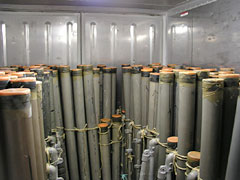

 | |||||||||||||||
|
|
Journals 2006/2007Miriam Sutton
August 25, 2006 AM Location: Slope off Saglek Bank (58° 14' 21.27" N, 59° 42' 36.10" W) I ventured into the Core Storage Bin this morning to take a closer look at the sediment cores and the process used to preserve them until the scientists can return to the lab at the Bedford Institute of Oceanography in Halifax, Nova Scotia. Each section of the core is coded and stored top side up, in the same position that it was retrieved from the seabed. This positioning also assists the scientists in applying one of the key laws of geologic science: The Law of Superposition. This law states that in undisturbed layers of sediment (or rock), the younger layers lie on top of the older layers. (See Cross-section illustrations below.)
Today's Activity: Use a shovel to pierce a section of compacted dirt in your yard. Try to insert the shovel as straight as you can through the top layers of soil. Insert the shovel between 8 and 10 inches deep into the ground and then pull the shovel toward you to reveal the different layers of sediment that have been deposited over the past several weeks or months. Observe and count as many different layers of sediment as you can. An alternative to this activity is to dig your shovel into the hard-packed sand the next time you're at the beach and observe the various layers left by the tides and waves along the seashore. Word of the Day: Ice Age REMINDER: Record today's Sea Surface Temperature (SST) and the Air Temperature on the data table you created from the August 05 journal entry. |
||||||||||||||

